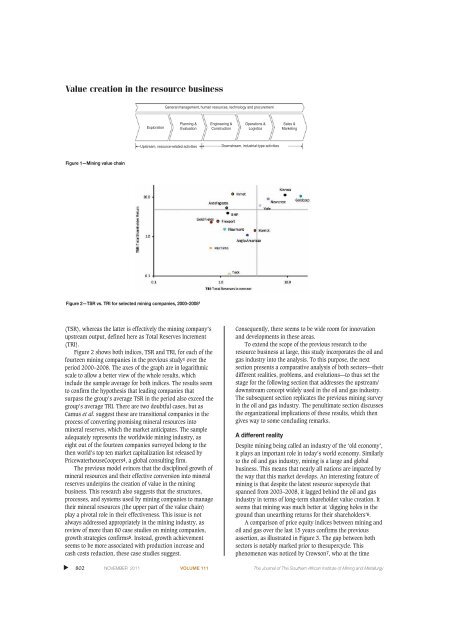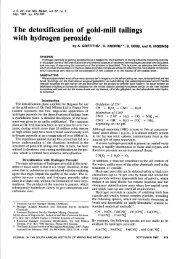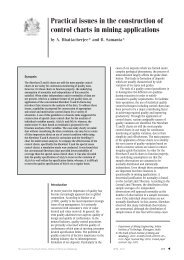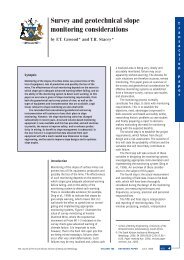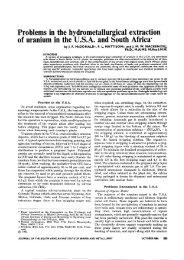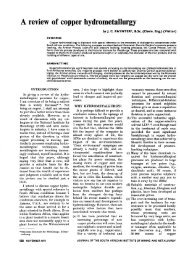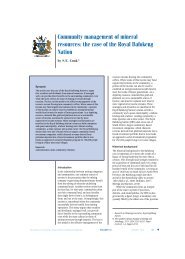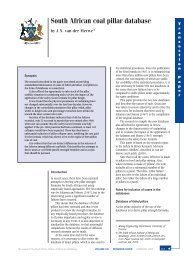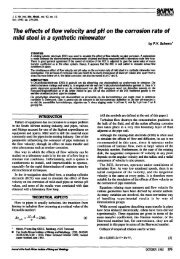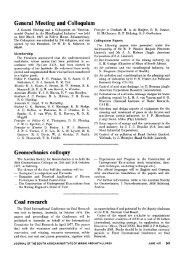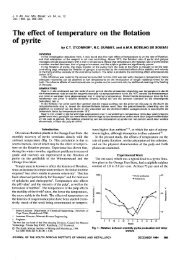Investigation of factors influencing the determination of ... - saimm
Investigation of factors influencing the determination of ... - saimm
Investigation of factors influencing the determination of ... - saimm
Create successful ePaper yourself
Turn your PDF publications into a flip-book with our unique Google optimized e-Paper software.
Value creation in <strong>the</strong> resource business<br />
General management, human resources, technology and procurement<br />
Exploration<br />
Planning &<br />
Evaluation<br />
Engineering &<br />
Construction<br />
Operations &<br />
Logistics<br />
Sales &<br />
Marketing<br />
Upstream, resource-related activities<br />
Downstream, industrial-type activities<br />
Figure 1—Mining value chain<br />
Figure 2—TSR vs. TRI for selected mining companies, 2000–2008 1<br />
(TSR), whereas <strong>the</strong> latter is effectively <strong>the</strong> mining company’s<br />
upstream output, defined here as Total Reserves Increment<br />
(TRI).<br />
Figure 2 shows both indices, TSR and TRI, for each <strong>of</strong> <strong>the</strong><br />
fourteen mining companies in <strong>the</strong> previous study1 over <strong>the</strong><br />
period 2000–2008. The axes <strong>of</strong> <strong>the</strong> graph are in logarithmic<br />
scale to allow a better view <strong>of</strong> <strong>the</strong> whole results, which<br />
include <strong>the</strong> sample average for both indices. The results seem<br />
to confirm <strong>the</strong> hypo<strong>the</strong>sis that leading companies that<br />
surpass <strong>the</strong> group’s average TSR in <strong>the</strong> period also exceed <strong>the</strong><br />
group’s average TRI. There are two doubtful cases, but as<br />
Camus et al. suggest <strong>the</strong>se are transitional companies in <strong>the</strong><br />
process <strong>of</strong> converting promising mineral resources into<br />
mineral reserves, which <strong>the</strong> market anticipates. The sample<br />
adequately represents <strong>the</strong> worldwide mining industry, as<br />
eight out <strong>of</strong> <strong>the</strong> fourteen companies surveyed belong to <strong>the</strong><br />
<strong>the</strong>n world’s top ten market capitalization list released by<br />
PricewaterhouseCoopers4, a global consulting firm.<br />
The previous model evinces that <strong>the</strong> disciplined growth <strong>of</strong><br />
mineral resources and <strong>the</strong>ir effective conversion into mineral<br />
reserves underpins <strong>the</strong> creation <strong>of</strong> value in <strong>the</strong> mining<br />
business. This research also suggests that <strong>the</strong> structures,<br />
processes, and systems used by mining companies to manage<br />
<strong>the</strong>ir mineral resources (<strong>the</strong> upper part <strong>of</strong> <strong>the</strong> value chain)<br />
play a pivotal role in <strong>the</strong>ir effectiveness. This issue is not<br />
always addressed appropriately in <strong>the</strong> mining industry, as<br />
review <strong>of</strong> more than 80 case studies on mining companies,<br />
growth strategies confirms5. Instead, growth achievement<br />
seems to be more associated with production increase and<br />
cash costs reduction, <strong>the</strong>se case studies suggest.<br />
Consequently, <strong>the</strong>re seems to be wide room for innovation<br />
and developments in <strong>the</strong>se areas.<br />
To extend <strong>the</strong> scope <strong>of</strong> <strong>the</strong> previous research to <strong>the</strong><br />
resource business at large, this study incorporates <strong>the</strong> oil and<br />
gas industry into <strong>the</strong> analysis. To this purpose, <strong>the</strong> next<br />
section presents a comparative analysis <strong>of</strong> both sectors—<strong>the</strong>ir<br />
different realities, problems, and evolutions—to thus set <strong>the</strong><br />
stage for <strong>the</strong> following section that addresses <strong>the</strong> upstream/<br />
downstream concept widely used in <strong>the</strong> oil and gas industry.<br />
The subsequent section replicates <strong>the</strong> previous mining survey<br />
in <strong>the</strong> oil and gas industry. The penultimate section discusses<br />
<strong>the</strong> organizational implications <strong>of</strong> <strong>the</strong>se results, which <strong>the</strong>n<br />
gives way to some concluding remarks.<br />
A different reality<br />
Despite mining being called an industry <strong>of</strong> <strong>the</strong> ‘old economy’,<br />
it plays an important role in today’s world economy. Similarly<br />
to <strong>the</strong> oil and gas industry, mining is a large and global<br />
business. This means that nearly all nations are impacted by<br />
<strong>the</strong> way that this market develops. An interesting feature <strong>of</strong><br />
mining is that despite <strong>the</strong> latest resource supercycle that<br />
spanned from 2003–2008, it lagged behind <strong>the</strong> oil and gas<br />
industry in terms <strong>of</strong> long-term shareholder value creation. It<br />
seems that mining was much better at ‘digging holes in <strong>the</strong><br />
ground than unearthing returns for <strong>the</strong>ir shareholders’6.<br />
A comparison <strong>of</strong> price equity indices between mining and<br />
oil and gas over <strong>the</strong> last 15 years confirms <strong>the</strong> previous<br />
assertion, as illustrated in Figure 3. The gap between both<br />
sectors is notably marked prior to <strong>the</strong>supercycle. This<br />
phenomenon was noticed by Crowson7, who at <strong>the</strong> time<br />
▲<br />
802 NOVEMBER 2011 VOLUME 111 The Journal <strong>of</strong> The Sou<strong>the</strong>rn African Institute <strong>of</strong> Mining and Metallurgy


